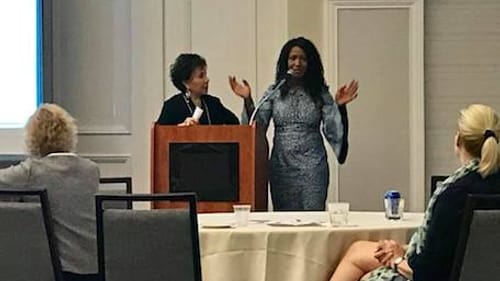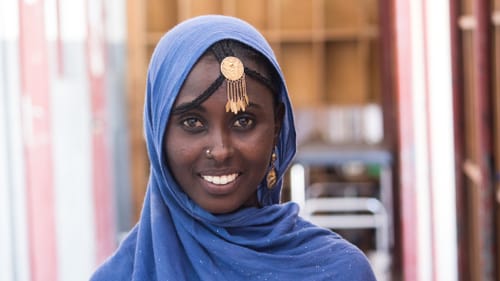Stay in the Loop
BSR publishes on a weekly schedule, with an email newsletter every Wednesday and Thursday morning. There’s no paywall, and subscribing is always free.
FGM: A big misunderstanding?
Dr. Fuambai Sia Ahmadu visits Philly’s Women International Leaders

What do you know about female genital mutilation (FGM)? You may know it’s an agonizing, primitive, dangerous, misogynistic practice, but as Sierra Leone native Dr. Fuambai Sia Ahmadu explained, “It’s an industry.”
One of the reasons is because droves of Westerners pour money toward organizations that promise to combat it. But what are we really opposing?
Ahmadu spoke to a September 26 gathering of Women International Leaders of Greater Philadelphia (WIL). The organization’s members aid women around the world through microfinance, grants, “surface projects,” and other support.
Bad terminology?
Ahmadu completed her PhD in social anthropology at the London School of Economics and did a National Institute of Mental Health postdoc at the University of Chicago’s Department of Comparative Human Development. She’s worked as a consultant for UNICEF and a principal investigator at the UK’s Medical Research Council Laboratories in the Gambia and has researched FGM across sub-Saharan Africa, including in her family’s own Kono culture in Sierra Leone, since 1995. (Her work inspired Seth Rozin’s recent drama Human Rites.)
The World Health Organization (WHO) calls FGM “a violation of the human rights of girls and women.” Many African women oppose it, including Kenyan activist Nice Nailantei Leng’ete. But Ahmadu (who underwent it herself as a child) has “no use for that terminology.”
“Mutilation works for the activists,” she said, comparing FGM to fearmongering, medically inaccurate terms used by U.S. anti-abortion activists. She calls it female circumcision, or, in Kono, bondo, an initiation into womanhood.
The program included a short film on the topic from the speaker’s sister, Sunju K. Ahmadu-Barrie. Produced in 2005 as part of Ahmadu-Barrie's graduate studies, it features scenes from ecstatic bondo ceremonies and interviews with local women.
Ahmadu said her platform is about women’s right to choose the procedure freely (or not), improving conditions for those who do, and “challenging the metanarrative” of female circumcision.
Facts on female circumcision
Female circumcision is not necessarily the terror described by anti-FGM activists. The WHO grades procedures that range from a ceremonial nick to the labia to the removal of the clitoral hood or, in some cases, the head of the clitoris and part of the inner labia, all the way to the near-total removal of the clitoral head and the inner labia, with the outer labia sewn together.

The latter is what Westerners most often hear about, but according to Ahmadu, it makes up only 10 percent of cases. (For me, this doesn’t lessen its horror.)
“There really isn’t much good science about this at all,” the scholar said. According to her research, minor forms of female circumcision don’t affect sexual satisfaction. She also emphasized that the Kono rite is controlled, celebrated, and performed by the women themselves, not at the requirement of men.
In Kono communities, bondo initiates are pampered with gifts in a celebration of singing and dancing that robustly affirms sexual pleasure (Kono women, she noted, may openly take lovers even after marriage).
But what about…
The speaker argued that common forms of female circumcision are equivalent to widely accepted procedures for boys across the world. She also noted that labiaplasty, a cosmetic procedure that reduces and shapes the labia, is also rated as a mid-grade form of female circumcision by the WHO. She claimed female circumcision is statistically no riskier than any other common surgical procedure.
But suggesting that female circumcision isn’t problematic because labiaplasty exists simply reveals Western women’s hypocrisy, rather than making a point about female circumcision. Labiaplasty is mostly a symptom of a misogynistic culture that is constantly demanding we shrink and carve our bodies. But at least women make a conscious decision to undergo it, unlike many who receive female circumcision in other cultures.
To me, one of the evening’s most revealing moments came when Ahmadu admitted for her sister’s camera that at her own Bondo, she was thrilled about the celebration while having no idea what was about to happen to her genitals.
This is the case with many girls who, the scholar said, are rushed into the rite at younger and younger ages. Once activists’ anti-FGM messages reach teenagers, an increasing number refuse the ceremony.
But Kono women who don’t undergo it, Ahmadu said, are bullied and ostracized by their peers. Does this mean circumcision is good? To me, promoting bondo because of the celebrations (and the ostracism for those who don’t participate) is like arguing that marriage is a good idea because weddings are fun and because women are scorned if they don’t marry.

“Free to Choose”
While Ahmadu argued that stereotypes of bleeding and infection are false, she did not otherwise address the procedure itself. What kinds of instruments are used? Are anesthetics involved? What medical care ensures safety? I listened to her lecture and perused the website of her Sierra Leone-based organization, All Women Are Free to Choose (AWA-FC), and didn’t find answers.
As for the claim that men have nothing to do with it — you won’t see men at American bridal showers or gown fittings, but that doesn’t mean the marriage-industrial complex isn’t a pillar of the patriarchy. Even if the rite in Kono communities is genuinely driven by women, AWA-FC’s own website links to a story about genital cutting in an eastern Ugandan village where husbands insist their wives undergo the procedure. (Ahmadu also did not address the relationship between FGM and child marriage.)
AWA-FC insists that circumcised women have the right to live without shame (and, yes, everyone should take pride in their own bodies), but neither Ahmadu nor AWA-FC combats the debilitating scorn experienced by women who eschew circumcision. Rather, they seem to uphold that scorn as an argument for the rite’s cultural significance.
Ahmadu’s research is worth a close look, especially for Western women whose concept of the rite is uprooted from thousands of years of cultural context, possibly tainted by racism, and exploited for financial gain by some activists. At the close of this program, whatever their feelings were, the WIL audience cheered the presentation of a $500 check to AWA-FC — a payment I would not make myself, though I appreciate Ahmadu’s scholarship and her right to her own views.
What, When, Where
Discourse on Female Genital Mutilation with Dr. Fuambai Sia Ahmadu. Women in Leadership. September 28, 2018, at the Courtyard by Marriott Downtown, 21 N. Juniper Street, Philadelphia. Wil-gp.org.
Sign up for our newsletter
All of the week's new articles, all in one place. Sign up for the free weekly BSR newsletters, and don't miss a conversation.

 Alaina Johns
Alaina Johns